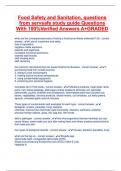Food Safety and Sanitation, questions
from servsafe study guide Questions
With 100%Verified Answers A+GRADED
what are the consequences/costs of having a food borne illness outbreaks? (8) - correct
answer...✔✔Loss of customers and sales,
loss of reputation,
negative media exposure,
lawsuits and legal fees,
increased insurance premiums,
lowered staff morale,
staff missing work,
staff retraining
five common risk factors that can cause food borne illnesses - correct answer...✔✔1.
purchasing food from unsafe sources
2. failing to cook food properly
3. holding food at incorrect temperatures
4. using contaminated equipment
5. practicing poor personal hygiene
Complete list of TCS foods - correct answer...✔✔milk/dairy products, meat (beef, lamb,
pork), fish, baked potatoes, shell eggs (unless treated to eliminate non typhoidal
salmonella), poultry, shellfish and crustaceans, heat-treated plant food (cooked rice,
beans, vegetables), tofu/soy products, sliced melons, cut tomatoes, cut leafy greens,
sprouts, untreated garlic-and-oil mixtures
Three types of contaminants and examples for each type - correct answer...✔✔
biological- viruses, parasites, fungi, bacteria
chemical- food service chemicals used incorrectly, cleaners, sanitizers, polishes
physical-foreign objects, glass, dirt, bag ties, fish bones
define pathogen - correct answer...✔✔tiny microorganisms that are harmless but can
cause illness, some make you sick after eating them and others produce poisons/toxins
that make you sick.
four types of biological hazards - correct answer...✔✔Viruses, bacteria, parasites, fungi
what are the big six - correct answer...✔✔Shigella spp.,
salmonella typhi, nontypoidal salmonella (NTS),
Shiga toxin-producing Escherichia coli (STEC) (AKA E Coli),
Hepatitis A,
,Norovirus
What does FATTOM mean to bacteria - correct answer...✔✔conditions for bacteria to
grow,
Food
Acidity
Temperature
Time
Oxygen
Moisture
what are the specific parameters for each of the FATTOM - correct answer...✔✔Food-
need carbs, proteins (meat, poultry, dairy products, eggs)
Acidity-grow best with neutral to slightly acidic
Temperature-danger zone (41-135 F, especially 70-125)
Time-more time, more opportunity
Oxygen-some need oxygen, some don't
Moisture-grow well in high moisture (remember water activity level)
revisit pathogen summary sheet/assignment - correct answer...✔✔read over it
What is a food borne-illness outbreak?
a.when two or more food handlers contaminate multiple food items
b. when an operation serves contaminated food to two or more people
c. when two or more people report the same illness from eating the same food
d. when the cdc receives information on two or more people with the same illness -
correct answer...✔✔c. when two or more people report the same illness from eating the
same food
What is TCS food?
a.food requiring thermometer checks for security
b.food requiring trustworthy conditions for service
c.food requiring training commitments for standards
d.food requiring time and temperature control for safety - correct answer...✔✔d.food
requiring time and temperature control for safety
Why are preschool-age children at a higher risk for food borne illnesses?
a. their appetites have increased since birth
b. they have not built up strong immune systems
c. they are more likely to spend time in a hospital
d. they are more likely to suffer allergic reactions - correct answer...✔✔b. they have not
built up strong immune systems
Which is a TCS food?
a. bread
b. flour
, c. sprouts
d. strawberries - correct answer...✔✔c. sprouts
The five common risk factors that can lead to foodborne illness are failing to cook food
adequately, holding food at incorrect temperatures, using contaminated equipment,
practicing poor hygiene, and
a. reheating leftover food
b. serving ready-to-eat food
c. using single-use, disposable gloves
d. purchasing foods from unsafe sources - correct answer...✔✔d. purchasing foods
from unsafe sources
What is an important measure for preventing food borne illness?
a. using new equipment
b. measuring pathogens
c. preventing cross-contamination
d. serving locally grown, organic food - correct answer...✔✔c. preventing cross-
contamination
Raw chicken breasts are left out at room temperature on a prep table. What is the main
risk that could cause a food borne illness?
a. cross-contamination
b. poor personal hygiene
c. time-temperature abuse
d. poor cleaning and sanitizing - correct answer...✔✔c. time-temperature abuse
A server cleans a dining table with a wiping cloth and then puts the wiping cloth in an
apron pocket. What is the risk that could cause a food borne illness?
a. cross-contamination
b. poor personal hygiene
c. time-temperature abuse
d. poor cleaning and sanitizing - correct answer...✔✔d. poor cleaning and sanitizing
What are the most common symptoms of a food borne illness?
a. diarrhea, vomiting, fever, nausea, abdominal cramps, and dizziness
b. diarrhea, vomiting, fever, nausea, abdominal cramps, and headache
c. diarrhea, vomiting, fever, nausea, abdominal cramps, and jaundice
d. diarrhea, vomiting, fever, nausea, abdominal cramps, and tiredness - correct
answer...✔✔c. diarrhea, vomiting, fever, nausea, abdominal cramps, and jaundice
What is the most important way to prevent a food borne illness caused by bacteria?
a. control time and temperature
b. prevent cross-contamination
c. practice good personal hygiene
d. practice correct cleaning and sanitizing - correct answer...✔✔a. control time and
temperature




